Persistent Organic Pollutants and Suspended Particulate Matter in Snow of Eastern Siberia in 2009–2023: Temporal Trends and Effects of Meteorological Factors and Recultivation Activities at Former Industrial Area
Abstract
1. Introduction
2. Materials and Methods
2.1. Study Site
2.2. Snow Sampling
2.3. Analysis of PCBs and OCPs
2.3.1. Sample Pretreatment and Instrumental Analysis of PCBs and OCPs
2.3.2. Quality Control and Quality Assurance (QA/QC)
2.4. Analysis of Suspended Particulate Matter
2.5. Data Analysis
2.6. Statistical Analysis
2.7. Backward and Forecast Trajectories Analysis
3. Results and Discussion
3.1. Backward and Forecast Air Trajectories
3.2. Characteristics of Some Meteorological Indexes in 2009–2023 and Snow Cover at the Time of Sampling
3.3. Suspended Particulate Matter in Snow
3.4. Organochlorine Concentrations in Snow from the Southern Part of the Irkutsk Region and Comparison with Data from Other Locations
3.4.1. HCB
3.4.2. HCHs and DDTs
3.4.3. PCBs
3.4.4. PCB-11
3.5. Deposition Rates and Daily Deposition Fluxes
3.6. Temporal Trend of Daily Deposition Fluxes of PCBs and OCPs and the Effect of Technogenic Activity in Southern Part of Irkutsk Region in 2009–2023
3.6.1. DDFs of HCHs and DDTs
3.6.2. DDFs of HCB and PCBs
3.7. The Relationship of Daily Deposition Fluxes (DDFs) of POPs with Suspended Particulate Matter (SPM) Load and Total Emissions from Stationary Sources in Irkutsk Region
3.8. Temperature, Precipitation, Air Humidity, and Sunshine Duration Effect on Daily Deposition Fluxes (DDFs) of PCBs and OCPs
4. Conclusions
Supplementary Materials
Author Contributions
Funding
Institutional Review Board Statement
Informed Consent Statement
Data Availability Statement
Acknowledgments
Conflicts of Interest
References
- Kobysheva, N.V.; Akenteva, E.M.; Bogdanova, E.G.; Karpenko, V.N.; Klyueva, M.V.; Lipovskaya, V.I.; Lugina, K.M.; Rasova, E.N.; Semenov, I.A.; Stadnik, V.V.; et al. Climate of Russia; Hydrometeoizdat: Saint-Peterburg, Russia, 2001; 656p. [Google Scholar]
- Wania, F.; Hoff, J.T.; Jia, C.Q.; Mackay, D. The effects of snow and ice on the environmental behavior of hydrophobic organic chemicals. Environ. Pollut. 1998, 102, 25–41. [Google Scholar] [CrossRef]
- Lei, Y.D.; Wania, F. Is rain or snow a more efficient scavenger of organic chemicals? Atmos. Environ. 2004, 38, 3557–3571. [Google Scholar] [CrossRef]
- Halsall, C.J. Investigating the occurrence of persistent organic pollutants (POPs) in the arctic: Their atmospheric behaviour and interaction with the seasonal snow pack. Environ. Pollut. 2004, 128, 163–175. [Google Scholar] [CrossRef]
- Lebedev, A.; Sinikova, N.; Nikolaeva, S.; Poliakova, O.; Khrushcheva, M.; Pozdnyakov, S. Metals and organic pollutants in snow surrounding an iron factory. Environ. Chem. Lett. 2003, 1, 107–112. [Google Scholar] [CrossRef]
- Franz, T.P.; Eisenreich, S.J. Snow scavenging of polychlorinated biphenyls and polycyclic aromatic hydrocarbons in Minnesota. Environ. Sci. Technol. 1998, 32, 1771–1778. [Google Scholar] [CrossRef]
- Dinu, M.; Moiseenko, T.; Baranov, D. Snowpack as Indicators of Atmospheric Pollution: The Valday Upland. Atmosphere 2020, 11, 462. [Google Scholar] [CrossRef]
- Blanco-Alegre, C.; Calvo, A.I.; Castro, A.; Oduber, F.; Alonso-Blanco, E.; Alves, C.; Cerqueira, M.; Lopez, R.; Lucarelli, F.; Nava, S.; et al. The role of snow in scavenging aerosol particles: A physical-chemical characterization. Sci. Total Environ. 2024, 906, 167608. [Google Scholar] [CrossRef]
- Kozhevnikov, A.Y.; Shutskiy, N.A.; Malkov, A.V.; Lahmanov, D.E. Inorganic and organic pollutants in the snow cover of the northern city. Int. J. Environ. Analyt. Chem. 2022, 1–15. Available online: https://www.tandfonline.com/doi/abs/10.1080/03067319.2022.2053964 (accessed on 8 December 2023). [CrossRef]
- Nazarenko, Y.; Kurien, U.; Nepotchatykh, O.; Rangel-Alvarado, R.B.; Ariya, P.A. Role of snow and cold environment in the fate and effects of nanoparticles and select organic pollutants from gasoline engine exhaust. Environ. Sci. Process. Impacts 2016, 18, 190–199. [Google Scholar] [CrossRef]
- Grannas, A.M.; Bogdal, C.; Hageman, K.J.; Halsall, C.; Harner, T.; Hung, H.; Kallenborn, R.; Klan, P.; Klanova, J.; Macdonald, R.W.; et al. The role of the global cryosphere in the fate of organic contaminants. Atmos. Chem. Phys. 2013, 13, 3271–3305. [Google Scholar] [CrossRef]
- Stocker, J.; Scheringer, M.; Wegmann, F.; Hungerbuhler, K. Modeling the effect of snow and ice on the global environmental fate and long-range transport potential of semivolatile organic compounds. Environ. Sci. Technol. 2007, 41, 6192–6198. [Google Scholar] [CrossRef]
- Meyer, T.; Wania, F. Organic contaminant amplification during snowmelt. Water Res. 2008, 42, 1847–1865. [Google Scholar] [CrossRef]
- Cousins, I.T.; Beck, A.J.; Jones, K.C. A review of the processes involved in the exchange of semi-volatile organic compounds (SVOC) across the air-soil interface. Sci. Total Environ. 1999, 228, 5–24. [Google Scholar] [CrossRef]
- Bizzotto, E.C.; Villa, S.; Vaj, C.; Vighi, M. Comparison of glacial and non-glacial-fed streams to evaluate the loading of persistent organic pollutants through seasonal snow/ice melt. Chemosphere 2009, 74, 924–930. [Google Scholar] [CrossRef]
- Demidenko, G.A.; Napesochniy, N.S. The assessment of the snow cover toxicity in the private plots located within Krasnoyarsk on the reaction of the infusorian (Paramecium caudatum) survival. Bull. KrasGAU 2014, 6, 176–182. (In Russian) [Google Scholar]
- Monitoring, A. Persistent Organic Pollutants; Arctic Assessment Report; Arctic Monitoring and Assessment Programme (AMAP): Oslo, Norway, 1998; Chapter 6; pp. 183–371. [Google Scholar]
- Stockholm Convention on Persistent Organic Pollutants. In Text and Annexes; Revised in 2019; United Nations Environmental Programme: Stockholm, Sweden, 2011; Volume 53, Available online: http://www.pops.int/TheConvention/Overview/TextoftheConvention/tabid/2232/Default.aspx (accessed on 21 November 2023).
- United Nations Environment Programme. Regionally Based Assessment of Persistent Toxic Substances: Central and North East Asia Regional Report; United Nations Environment Programme, Chemicals; Global Environment Facility; UN, UNEP: Geneva, Switzerland, 2002; 115p, Available online: https://digitallibrary.un.org/record/487287 (accessed on 21 November 2023).
- United Nations Environment Programme. Standardized Toolkit for Identification and Quantification of Dioxin and Furan Releases, 1st ed. 2003. Available online: https://wedocs.unep.org/20.500.11822/32443 (accessed on 21 November 2023).
- Mamontov, A.A.; Mamontova, E.A.; Tarasova, E.N.; McLachlan, M.S. Tracing the Sources of PCDD/Fs and PCBs to Lake Baikal. Environ. Sci. Technol. 2000, 34, 741–747. [Google Scholar] [CrossRef]
- Mamontova, E.A.; Mamontov, A.A.; Tarasova, E.N. Ecological and hygienic assessment of the consequences of the pollution with persistent organic compounds of an industrial town (by the example of Usol’e-Sibirskoe): I. Atmospheric air, snow, and soil. Russ. J. Gen. Chem. 2016, 86, 2987–2996. [Google Scholar] [CrossRef]
- Gritsenko, A.V. (Ed.) Atlas of Irkutsk Region; Publishing of The Main Directorate of Geodesy and Cartography; Ministry of Geology and Subsoil Protection of the USSR: Moscow/Irkutsk, Russia, 1962; 182p. (In Russian)
- Galazy, G.I. (Ed.) Atlas of Lake Baikal; Publishing House of the Federal Service of Geodesy and Cartography of Russia: Moscow, Russia, 1993; 160p. (In Russian) [Google Scholar]
- Kostrova, S.S.; Meyer, H.; Fernandoy, F.; Werner, M.; Tarasov, P.E. Moisture origin and stable isotope characteristics of precipitation in southeast Siberia. Hydrol. Process. 2020, 34, 51–67. [Google Scholar] [CrossRef]
- Korytnyi, L.M.; Batuev, A.R.; Belov, A.V.; Bezrukov, L.A.; Bogdanov, V.N.; Ryashenko, S.V. (Eds.) Atlas of Development of Irkutsk; Publishing House of Sochava Institute of Geography, Siberian Branch of the Russian Academy of Science: Irkutsk, Russia, 2011; 131p. (In Russian) [Google Scholar]
- Maksyutova, E.V. Regime of snow cover in the Baikal region under the climate change. Led Sneg 2017, 57, 221–230. (In Russian) [Google Scholar] [CrossRef][Green Version]
- Ippolitova, N.A.; Kovalenko, S.N.; Orel, G.F. Geography of Irkutsk Region; Publishing House Sochava Institute of Geography, Siberian Branch of the Russian Academy of Science: Irkutsk, Russia, 2013; 233p. (In Russian) [Google Scholar]
- Galkin, S.S.; Bobylev, S.; Burlakova, E.A.; Wagan, I.; Vasiliev, I.V.; Volkov, I.N.; Gokhberg, L.; Egorenko, S.; Zavarina, E.S.; Zarubina, E.V.; et al. Russian Statistical Yearbook 2022; Rosstat: Moscow, Russia, 2022; 691p. Available online: https://eng.rosstat.gov.ru/storage/mediabank/Yearbook_2022.pdf (accessed on 8 August 2023).
- Rukavishnikov, V.S.; Efimova, N.V.; Golubinsky, E.P.; Maramovich, A.S.; Kosilko, S.A.; Kalinovsky, A.I.; Rodzikovsky, A.V.; Bezgodov, I.V. Contemporary problems of medical- biological and ecological safety of Irkutsk Region. Acta Biomed. Sci./Bull. VSNC SB RAMS 2007, 6, 6–12. (In Russian) [Google Scholar]
- Efimova, N.V. Problems of environmental health: Retrospective analysis on the example Irkutsk Oblast. Acta Biomed. Sci./Bull. VSNC SB RAMS 2013, 3, 57–61. (In Russian) [Google Scholar]
- Mamontova, E.A.; Tarasova, E.N.; Mamontov, A.A.; Kuzmin, M.I.; McLachlan, M.S.; Khomutova, M.I. The influence of soil contamination on the concentrations of PCBs in milk in Siberia. Chemosphere 2007, 67, S71–S78. [Google Scholar] [CrossRef]
- Schamanskiy, V.F. Usol’e-Sibirskoe; Publishing House of Eastern Siberia: Irkutsk, Russia, 1994; 219p. (In Russian) [Google Scholar]
- What’s at Khimprom in Usol’e-Sibirskoe? Available online: https://vk.com/usolesibir (accessed on 20 November 2023). (In Russian).
- Koval, P.V.; Rusch, E.A.; Koroleva, G.P.; Udodov, I.N.; Andrulaytis, L.D. Assessment of the impact of a source of mercury pollution on the components of the natural environment of the Angara region. Ecol. Vestn. Sev. Kavk. 2006, 2, 41–59. (In Russian) [Google Scholar]
- The Order of 29 October 2020 No 2819-r Action Plan (“Roadmap”) for the Prevention and Elimination of Environmental Pollution in the Territory of the Urban District of Usol’e-Sibirskoe, Irkutsk Region, as a Result of Economic Activities Related to the Production of Chemical Products. Available online: http://static.government.ru/media/files/lZmADFuqAZOYIxXJJGTd0ddGGAoL4EOy.pdf (accessed on 21 November 2023). (In Russian)
- Mamontova, E.A.; Tarasova, E.N.; Mamontov, A.A. Concentration of persistent organic pollutants in soil, snow water, and vegetation in southern Baikal region. Meteorol. Hydrol. 2019, 2, 86–98. (In Russian) [Google Scholar]
- Mamontova, E.A.; Mamontov, A.A. Spatial and temporal variations of polychlorinated biphenyls and organochlorine pesticides in snow in Eastern Siberia. Atmosphere 2022, 13, 2117. [Google Scholar] [CrossRef]
- Mamontova, E.A.; Tarasova, E.N.; Mamontov, A.A.; Mamontov, A.M. Freshwater seal as a source of direct and indirect increased human exposure to persistent organic pollutants in a background area. Sci. Total Environ. 2020, 715, 136922. [Google Scholar] [CrossRef]
- Tarasova, E.N.; Mamontova, E.A.; Mamontov, A.A. Organic matter and biogenic elements in snow cover the Lake Baikal Region. In Proceedings of the Problems of Ecological Geochemistry, Minsk, Belarus, 25–26 June 2008. (In Russian). [Google Scholar]
- PND F 14.1:2:4.254-2009; Methodology for Measurement of Mass Concentrations of Suspended and Calcined Suspended Substances in Sample of Drinking, Natural and Wastewater Using the Gravimetric Method. ZAO “Rosa”: Moscow, Russia, 2017; 12p.
- Revich, B.A.; Saet, Y.E.; Smirnova, R.S. Methodical Recommendations for Assessing the Degree of Pollution of Atmospheric Air in Populated Areas with Metals by Their Content in the Snow Cover and Soil; IMGRE: Moscow, Russia, 1990; 9p, Available online: https://meganorm.ru/Index2/1/4293736/4293736062.htm (accessed on 8 August 2023). (In Russian)
- Bulygina, O.N.; Rasuvaev, V.N.; Trofimenko, L.T.; Schvets, N.V. The Description of the Database of Month Air Temperature at Stations in Russia. Certificate of State Registration of the Database No 2014621485. Available online: http://meteo.ru/data/156-temperature (accessed on 22 August 2023). (In Russian).
- Bulygina, O.N.; Razyvaev, V.N.; Korshunova, N.N.; Schvets, N.V. The Description of the Database of Month Volumes of Precipitations at Stations in Russia. Certificate of State Registration of the Database No 2015620394. Available online: http://meteo.ru/data/158-total-precipitation (accessed on 22 August 2023). (In Russian).
- Keznetsova, V.N.; Davletshin, S.G.; Schvets, N.V. The Description of the Database of Relative Humidity at Meteorological Stations in Russia. Certificate of State Registration of the Database No 2019621537 at 2 September 2019. Available online: http://meteo.ru/data/790-srednemesyachnaya-otnositelnaya-vlazhnost-vozdukha (accessed on 22 August 2023). (In Russian).
- Apasova, E.G.; Kleschenko, L.K. The Description of the Database of Sums Months Sunshine Duration at Stations in Russia. Certificate of State Registration of the Database No 2015621446. Available online: http://meteo.ru/data/160-sunshine-duration (accessed on 22 August 2023). (In Russian).
- Bulygina, O.N.; Razyvaev, V.N.; Alexandrova, T.M. The Description of the Database of Dates od Characteristics of Snow Cover at Meteorological Stations in Russia and Former USSR. Certificate of State Registration of the Database No 2014621201. Available online: http://meteo.ru/data/165-snow-cover (accessed on 22 August 2023). (In Russian).
- Russian Statistical Yearbook 2009; Rosstat: Moscow, Russia, 2009; 795p. Available online: https://rosstat.gov.ru/storage/mediabank/year09.zip (accessed on 8 August 2023). (In Russian)
- Russian Statistical Yearbook 2012; Rosstat: Moscow, Russia, 2012; 786p. Available online: https://rosstat.gov.ru/storage/mediabank/year12.rar (accessed on 8 August 2023). (In Russian)
- Russian Statistical Yearbook 2013; Rosstat: Moscow, Russia, 2013; 717p. Available online: https://rosstat.gov.ru/storage/mediabank/year13.rar (accessed on 8 August 2023). (In Russian)
- Russian Statistical Yearbook 2014; Rosstat: Moscow, Russia, 2014; 693p. Available online: https://rosstat.gov.ru/storage/mediabank/year14.rar (accessed on 8 August 2023). (In Russian)
- Russian Statistical Yearbook 2015; Rosstat: Moscow, Russia, 2015; 728p. Available online: https://rosstat.gov.ru/storage/mediabank/year15.rar (accessed on 8 August 2023). (In Russian)
- Russian Statistical Yearbook 2016; Rosstat: Moscow, Russia, 2016; 725p. Available online: https://rosstat.gov.ru/storage/mediabank/year16_el-vers.rar (accessed on 8 August 2023). (In Russian)
- Russian Statistical Yearbook 2017; Rosstat: Moscow, Russia, 2017; 689p. Available online: https://gks.ru/bgd/regl/b17_13/Main.htm (accessed on 8 August 2023).
- Russian Statistical Yearbook 2018; Rosstat: Moscow, Russia, 2018; 694p. Available online: https://eng.rosstat.gov.ru/storage/mediabank/year18(1).pdf (accessed on 8 August 2023).
- Russian Statistical Yearbook 2019; Rosstat: Moscow, Russia, 2019; 708p. Available online: https://eng.rosstat.gov.ru/storage/mediabank/Ejegodnik_2019(1).pdf (accessed on 8 August 2023).
- Russian Statistical Yearbook 2020; Rosstat: Moscow, Russia, 2020; 700p. Available online: https://eng.rosstat.gov.ru/storage/mediabank/Ejegodnik_2020(1).pdf (accessed on 8 August 2023).
- Russian Statistical Yearbook 2021; Rosstat: Moscow, Russia, 2021; 692p. Available online: https://eng.rosstat.gov.ru/storage/mediabank/Ejegodnik_2021(1).pdf (accessed on 8 August 2023).
- Bulygina, O.N.; Rasuvaev, V.N.; Alexandrova, T.M. The Description of the Database of Daily Air Temperature and Precipitation at Meteorological Stations in Russia and the Former USSA (TTTR). Certificate of State Registration of the Database No. 014620942. Available online: http://meteo.ru/data/162-temperature-precipitation (accessed on 22 August 2023). (In Russian).
- Stein, A.F.; Draxler, R.R.; Rolph, G.D.; Stunder, B.J.B.; Cohen, M.D.; Ngan, F. NOAA’s HYSPLIT atmospheric transport and dispersion modeling system. Bull. Am. Meteorol. Soc. 2015, 96, 2059–2077. [Google Scholar] [CrossRef]
- Rolph, G.; Stein, A.; Stunder, B. Real-time Environmental Applications and Display sYstem: READY. Environ. Model. Softw. 2017, 95, 210–228. [Google Scholar] [CrossRef]
- Climatological Standard Normals (1991–2020). Available online: https://www.nodc.noaa.gov/archive/arc0216/0253808/2.2/data/0-data/Region-2-WMO-Normals-9120/ (accessed on 4 October 2023).
- Climatological Reference Normals (1961–1990). Available online: https://www.ncei.noaa.gov/pub/data/normals/WMO/1961-1990/RA-II/ (accessed on 4 October 2023).
- Moskovchenko, D.; Pozhitkov, R.; Lodygin, E.; Toptygina, M. Polycyclic aromatic hydrocarbons in the snow cover in the city of Tyumen (Western Siberia, Russia). Toxics 2022, 10, 743. [Google Scholar] [CrossRef]
- Naserikia, M.; Hart, M.A.; Nazarian, N.; Bechtel, B.; Lipson, M.; Nice, K.A. Land surface and air temperature dynamics: The role of urban form and seasonality. Sci. Total Environ. 2023, 905, 167306. [Google Scholar] [CrossRef]
- Levshina, S. Distribution of hydrocarbons in the snow cover of natural and urbanized landscapes in the south of the Far East, Russia. Bull. Environ. Contam. Toxicol. 2023, 111, 56. [Google Scholar] [CrossRef] [PubMed]
- Shevchenko, V.P.; Vorobyev, S.N.; Krickov, I.V.; Boev, A.G.; Lim, A.G.; Novigatsky, A.N.; Starodymova, D.P.; Pokrovsky, O.S. Insoluble particles in the snowpack of the Ob River Basin (Western Siberia) a 2800 km submeridional profile. Atmosphere 2020, 11, 1184. [Google Scholar] [CrossRef]
- Shumilova, M.A.; Sadiullina, O.V. Snow cover as a universal indicator of the urban environment pollution by the example of Izhevsk. Bull. Udmurt Univ. Phys. Chem. Ser. 2011, 2, 91–96. (In Russian) [Google Scholar]
- Moskovchenko, D.V.; Pozhitkov, R.Y.; Minkina, T.M.; Sushkova, S.N. Trace metals and polycyclic aromatic hydrocarbons in the snow cover of the city of Nizhnevartovsk (Western Siberia, Russia). Arch. Environ. Contam. Toxicol. 2023, 84, 101–118. [Google Scholar] [CrossRef] [PubMed]
- Carrera, G.; Fernandez, P.; Vilanova, R.M.; Grimalt, J.O. Persistent organic pollutants in snow from European high mountain areas. Atmos. Environ. 2001, 35, 245–254. [Google Scholar] [CrossRef]
- Arellano, L.; Fernandez, P.; Tatosova, J.; Stuchlik, E.; Grimalt, J.O. Long-Range Transported Atmospheric Pollutants in Snowpacks Accumulated at Different Altitudes in the Tatra Mountains (Slovakia). Environ. Sci. Technol. 2011, 45, 9268–9275. [Google Scholar] [CrossRef]
- Moskovchenko, D.V.; Babushkin, A.G. Peculiarities of formation of chemical composition of snow waters (on example of Khanty-Mansi autonomous district). Earth Cryosphere 2012, 16, 71–81. (In Russian) [Google Scholar]
- Saet, I.E.; Revich, B.A.; Yanin, E.P.; Smirnova, R.S.; Basharkevich, I.L.; Onischenko, T.L.; Pavlova, L.N.; Trephilova, N.I.; Achkasov, A.I.; Sarkisyn, S.S. Geochemistry of Environment; Publishing House “Nedra”: Moscow, Russia, 1990; 335p. (In Russian) [Google Scholar]
- Litau, V.V.; Talovskaya, A.V.; Yazikov, E.G.; Lonchacova, A.D.; Tret’yakova, M.I. The assessment of dust pollution of the territory of the town of Omsk according to data of snow study. Opt. Atmos. Okeana 2015, 28, 256–259. (In Russian) [Google Scholar]
- Kasimov, N.S.; Kosheleva, N.E.; Vlasov, D.V.; Terskaya, E.V. Geochemistry of snow cover within the eastern district of Moscow. Vestn. Mosk. Universiteta. Ser. Geogr. 2012, 5, 14–24. (In Russian) [Google Scholar]
- Chudinova, O.N.; Norboeva, S.B. Assessment of snow cover pollution in the location of exposure to thermal power facilities. Bull. Baikal State Univ. 2023, 33, 121–129. (In Russian) [Google Scholar]
- Talovskaya, A.V. Geochemical characteristic of dust atmospheric precipitations on the Tomsk area. Opt. Atmos. Okeana 2010, 23, 519–524. (In Russian) [Google Scholar]
- Kholodova, M.S.; Procekin, S.N.; Tirskikh, E.N.; Dolgikh, P.G. Features of the microelement composition of the snow cover of the town of Usol’e-Sibirskoe. In Geomorphology and Physical Geography of Siberia; Batmanova, A.S., Gus’kova, T.A., Eds.; Publishing house of Tomsk State University: Tomsk, Russia, 2020; pp. 150–153. (In Russian) [Google Scholar]
- SanPiN 1.2.3685-21; Hygienic Standards and Requirements for Ensuring the Safety and (or) Harmlessness of Environmental Factors for Humans. Federal Center of Hygiene and Epidemiology: Moscow, Russia, 2021. Available online: http://https://docs.cntd.ru/document/573500115 (accessed on 5 December 2023). (In Russian)
- Finizio, A.; Villa, S.; Raffaele, F.; Vighi, M. Variation of POP concentrations in fresh-fallen snow and air on an Alpine glacier (Monte Rosa). Ecotoxicol. Environ. Saf. 2006, 63, 25–32. [Google Scholar] [CrossRef] [PubMed]
- Kang, J.-H.; Choi, S.-D.; Park, H.; Baek, S.-Y.; Hong, S.; Chang, Y.-S. Atmospheric deposition of persistent organic pollutants to the East Rongbuk Glacier in the Himalayas. Sci. Total Environ. 2009, 408, 57–63. [Google Scholar] [CrossRef] [PubMed]
- Cabrerizo, A.; Muir, D.C.G.; Teixeira, C.; Lamoureux, S.F.; Lafreniere, M.J. Snow deposition and melting as drivers of polychlorinated biphenyls and organochlorine pesticides in Arctic rivers, lakes, and ocean. Environ. Sci. Technol. 2019, 53, 14377–14386. [Google Scholar] [CrossRef]
- Casal, P.; Casas, G.; Vila-Costa, M.; Cabrerizo, A.; Pizarro, M.; Jimenez, B.; Dachs, J. Snow Amplification of Persistent Organic Pollutants at Coastal Antarctica. Environ. Sci. Technol. 2019, 53, 8872–8882. [Google Scholar] [CrossRef]
- On Approval of Water Quality Standards for Water Bodies of Fishery Significance, Including Standards for Maximum Permissible Concentrations of Harmful Substances in the Waters of Water Bodies of Fishery Significance; Order N 552 Dater; Ministry of Agriculture of the Russian Federation: Moscow, Russia, 2016. Available online: https://docs.cntd.ru/document/420389120 (accessed on 22 November 2022). (In Russian)
- Savchenkov, M.F.; Ignat’eva, L.P. Hygiene of the Application of Pesticides in Siberia; Publishing House of Irkutsk State University: Irkutsk, Russia, 1994; 184p. (In Russian) [Google Scholar]
- Mackay, D.; Shiu, W.Y.; Ma, K.-C.; Lee, S.C. Handbook of Physical—Chemical Properties and Environmental Fate for Organic Chemicals, 2nd ed.; Taylor & Francis Group: Boca Raton, FL, USA, 2006; 4181p. [Google Scholar]
- Klisenko, M.A. Handbook. Methods for Determining Microquantities of Pesticides in Food, Feed and the Environment; Kolos: Moscow, Russia, 1992; 565p. (In Russian) [Google Scholar]
- Fedorov, L.A.; Yablokov, A.V. Pesticides: A Toxic Blow to the Biosphere and Humans; Nauka Publishing House: Moscow, Russia, 1999; 462p. (In Russian) [Google Scholar]
- Hygienic Standards for the Content of Pesticides in the Environment (the List); GN 1.2.3539-18; Federal Center of Hygiene and Epidemiology: Moscow, Russia, 2018; Available online: https://files.stroyinf.ru/Data2/1/4293737/4293737113.pdf (accessed on 21 November 2023). (In Russian)
- Cipro, C.V.Z.; Taniguchi, S.; Montone, R.C. Organic pollutants in snow and seasonal melting water from King George Island, Antarctica. Water Air Soil Pollut. 2017, 228, 149. [Google Scholar] [CrossRef]
- Mamontova, E.A.; Mamontov, A.A. Air monitoring of polychlorinated biphenyls and organochlorine pesticides in Eastern Siberia: Levels, temporal trends, and risk assessment. Atmosphere 2022, 13, 1971. [Google Scholar] [CrossRef]
- Lebedev, A.T.; Polyakova, O.V.; Mazur, D.M.; Bol’shov, M.A.; Seregina, I.F. Estimation of contamination of atmosphere of Moscow in winter. J. Anal. Chem. 2012, 67, 1039–1049. [Google Scholar] [CrossRef]
- Amirgaliyev, N.A.; Medeu, A.R.; Opp, C.; Madibekov, A.; Kulbekova, R.; Ismukhanova, L.; Zhadi, A. Polychlorinated Biphenyls in the Snow Cover of South-Eastern Kazakhstan. Appl. Sci. 2022, 12, 8660. [Google Scholar] [CrossRef]
- Blais, J.M.; Froese, K.L.; Schindler, D.W.; Muir, D.C.G. Assessment of PCBs in Snow and Lake Sediments Following a Major Release from the Alberta Special Waste Treatment Centre Near Swan Hills, Alberta, Canada. Organohalogen Compd. 1998, 39, 189–192. [Google Scholar]
- Korhonen, M.; Verta, M.; Salo, S.; Vuorenmaa, J.; Kiviranta, H.; Ruokojärvi, P. Atmospheric bulk deposition of polychlorinated dibenzo-p-dioxins, dibenzofurans, and polychlorinated biphenyls in Finland. J. Mar. Sci. Eng. 2016, 4, 56. [Google Scholar] [CrossRef]
- Melnikov, S.; Carroll, J.; Gorshkov, A.; Vlasov, S.; Dahle, S. Snow and ice concentrations of selected persistent pollutants in the Ob–Yenisey River watershed. Sci. Total Environ. 2003, 306, 27–37. [Google Scholar] [CrossRef] [PubMed]
- Anh, H.Q.; Watanabe, I.; Minh, T.B.; Takahashi, S. Unintentionally produced polychlorinated biphenyls in pigments: An updated review on their formation, emission sources, contamination status, and toxic effects. Sci. Total Environ. 2021, 755, 142504. [Google Scholar] [CrossRef] [PubMed]
- Khairy, M.A.; Luek, J.L.; Dickhut, R.; Lohmannm, R. Levels, sources and chemical fate of persistent organic pollutants in the atmosphere and snow along the western Antarctic Peninsula. Environ. Pollut. 2016, 216, 304–313. [Google Scholar] [CrossRef]
- Vecchiato, M.; Argiriadis, E.; Zambon, S.; Barbante, C.; Toscano, G.; Gambaro, A.; Piazza, R. Persistent organic pollutants (POPs) in Antarctica: Occurrence in continental and coastal surface snow. Microchem. J. 2015, 119, 75–82. [Google Scholar] [CrossRef]
- Garmash, O.; Hermanson, M.H.; Isaksson, E.; Schwikowski, M.; Divine, D.; Teixeira, C.; Muir, D.C.G. Deposition history of polychlorinated biphenyls to the Lomonosovfonna Glacier, Svalbard: A 209 congener analysis. Environ. Sci. Technol. 2013, 47, 12064–12072. [Google Scholar] [CrossRef]
- Ivanov, V.; Sandell, E. Characterization of polychlorinated biphenyl isomers in Sovol and Trichlorodiphenyl formulations by high-resolution gas chromatography with electron capture detection and high-resolution gas chromatography—Mass spectrometry techniques. Environ. Sci. Technol. 1992, 26, 2012–2017. [Google Scholar] [CrossRef]
- Treger, Y.A. Stockholm convention on persistent organic pollutants: The ways of its implementation in the Russian Federation. Russ. J. Phys. Chem. B 2012, 6, 647–651. [Google Scholar] [CrossRef]
- Matykiewiczová, N.; Klánová, J.; Klán, P. Photochemical Degradation of PCBs in Snow. Environ. Sci. Technol. 2007, 41, 8308–8314. [Google Scholar] [CrossRef]
- Bower, J.P.; Anastasio, C. Degradation of organic pollutants in/on snow and ice by singlet molecular oxygen (1O*2) and an organic triplet excited state. Environ. Sci. Process. Impacts 2014, 16, 748–756. [Google Scholar] [CrossRef]
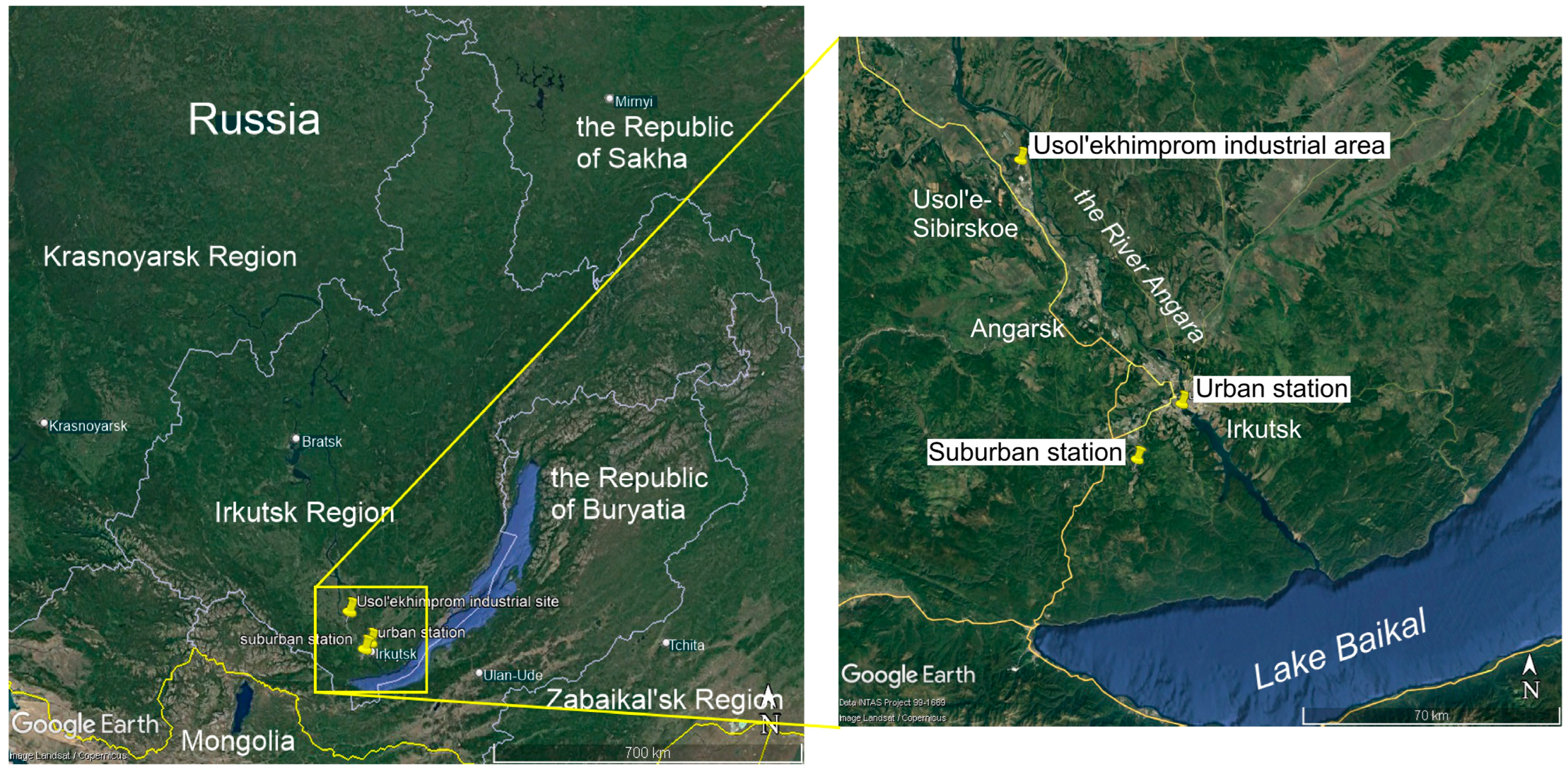
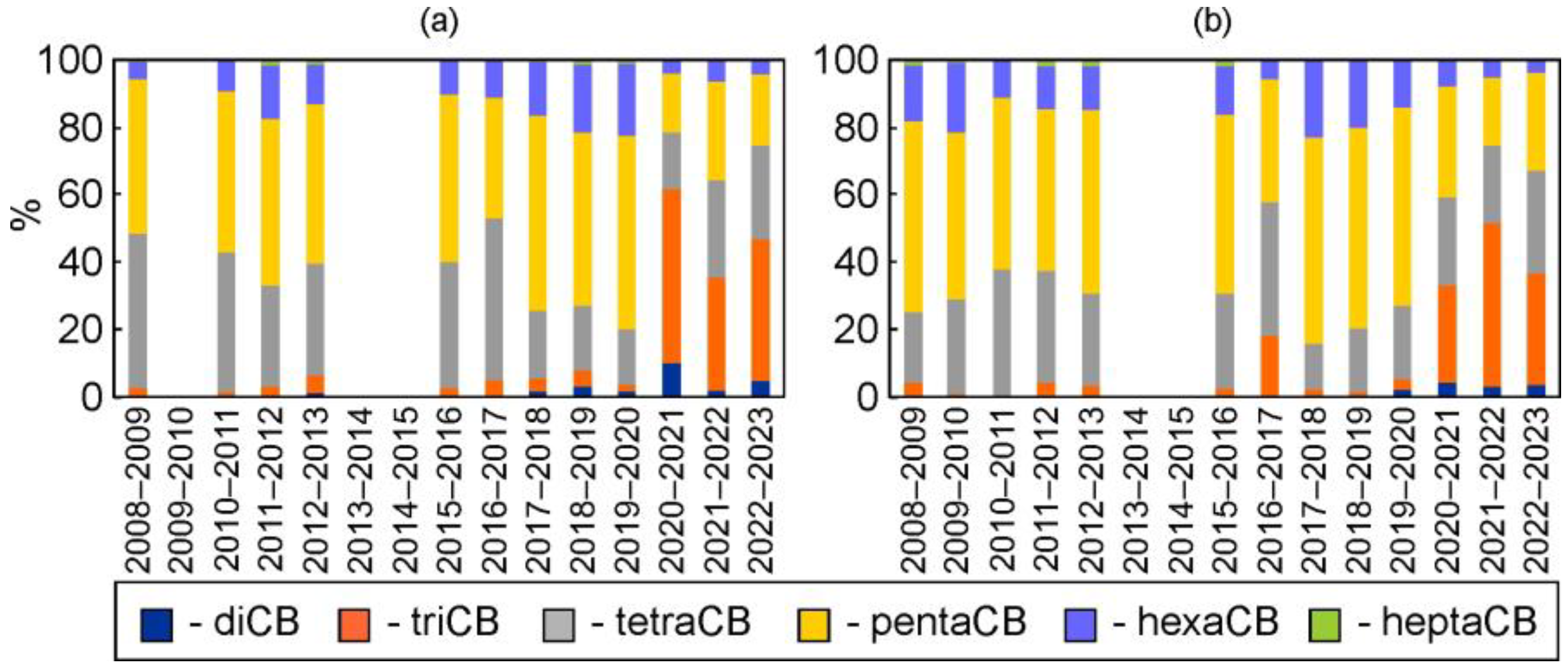
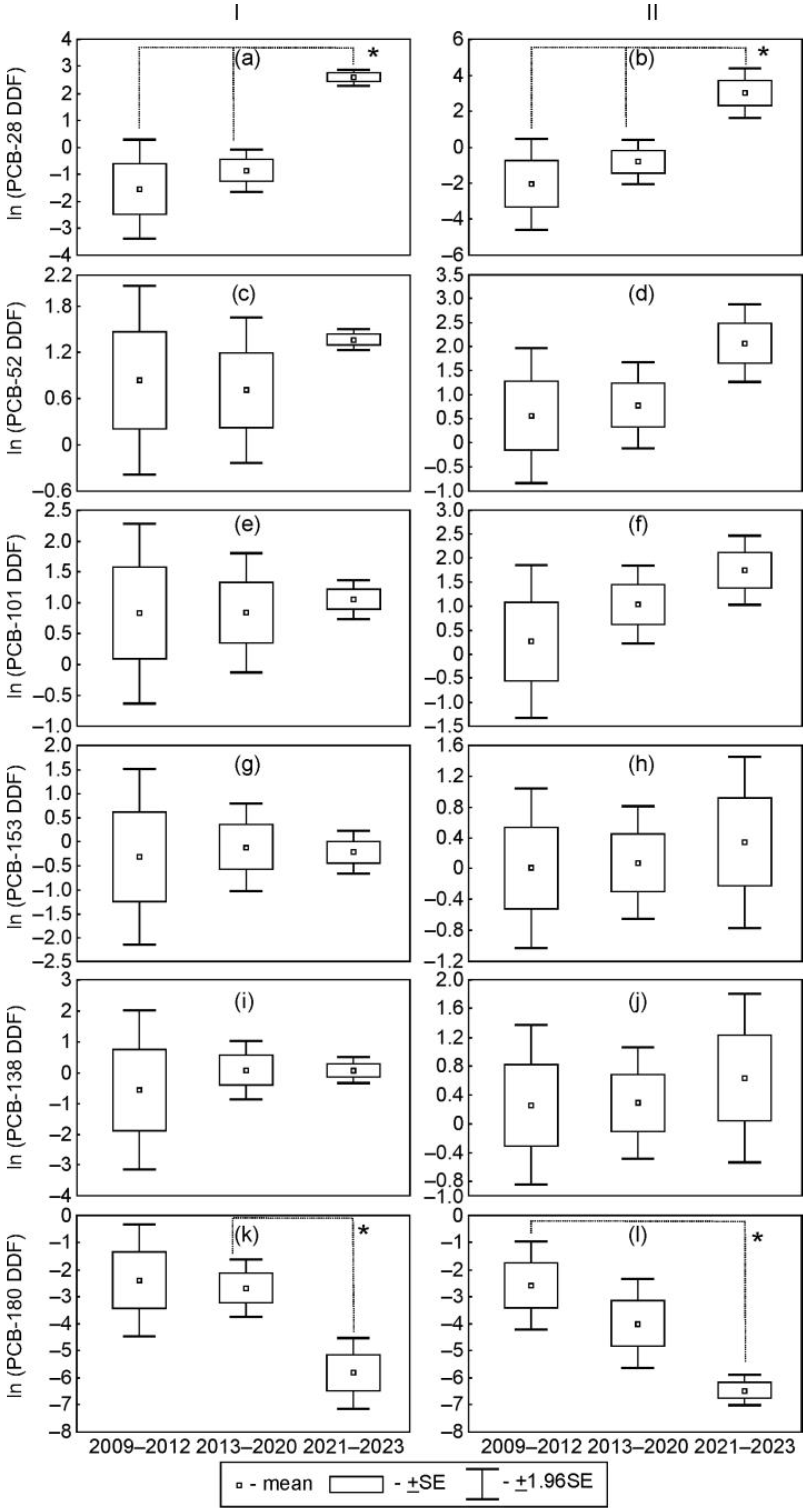
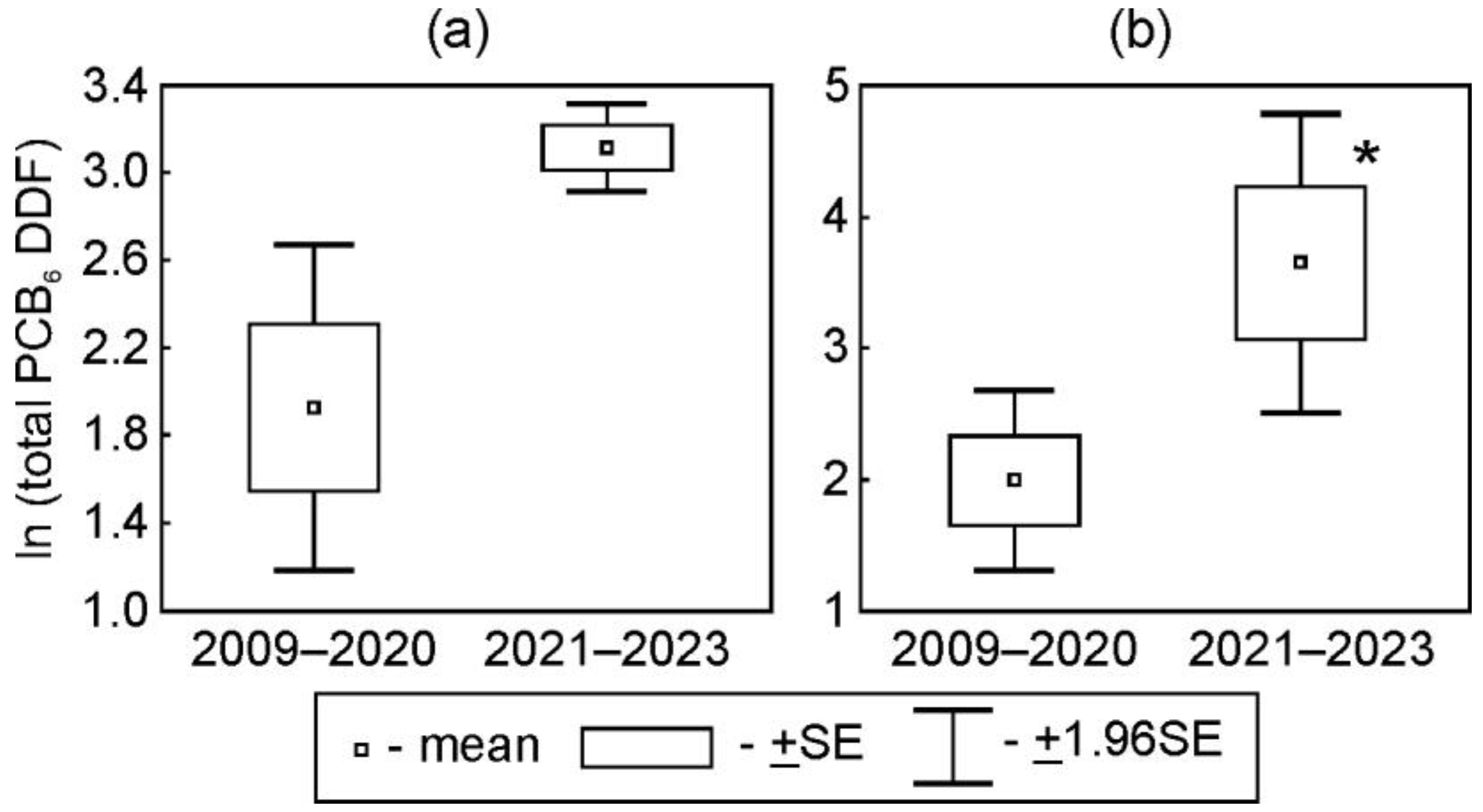
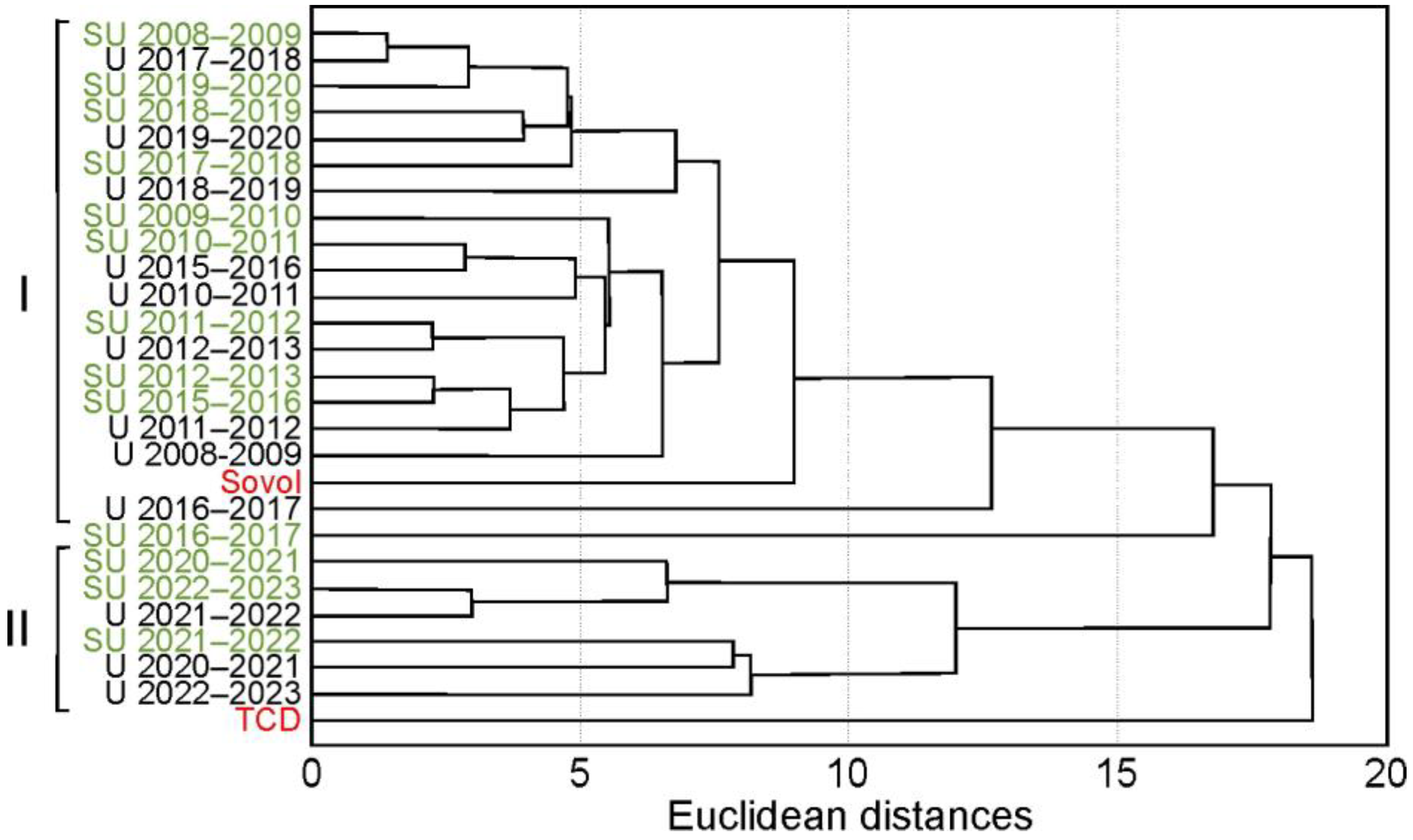
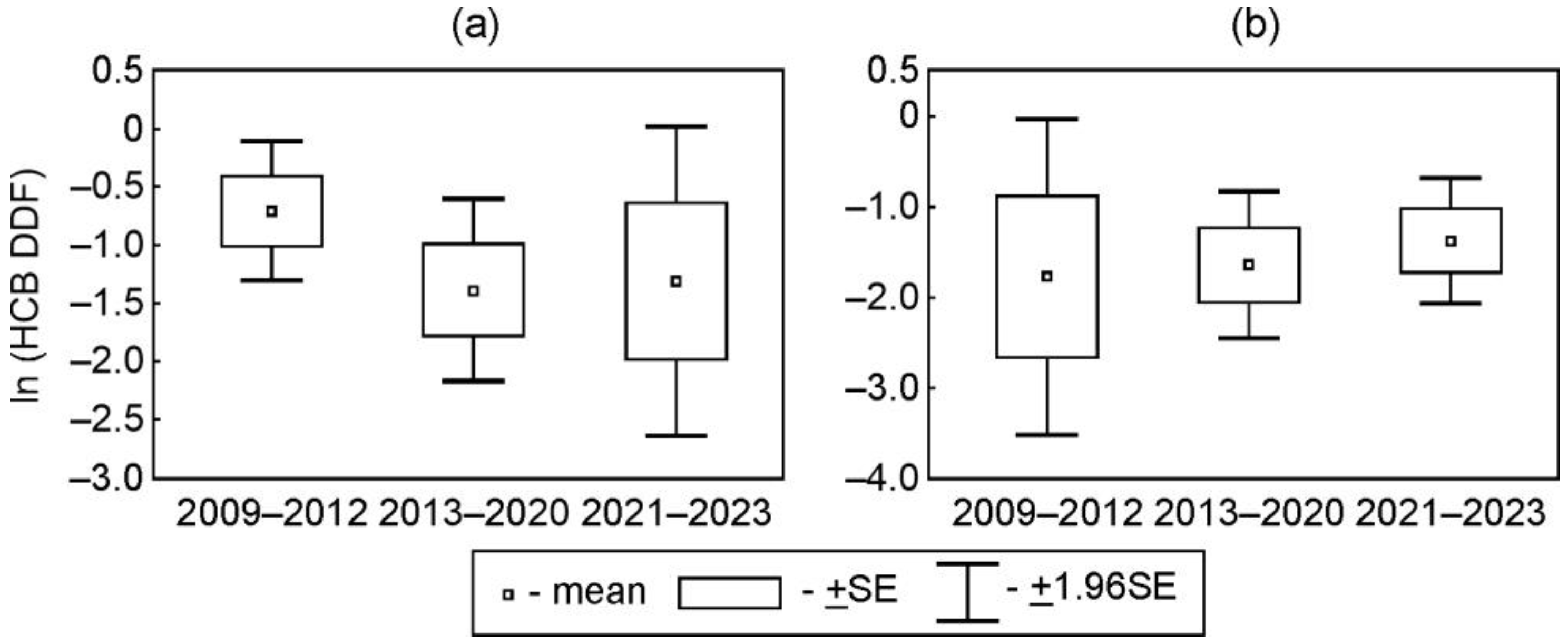
| Characteristic | N | Mean | Median | Min | Max | SD * | SE ** |
|---|---|---|---|---|---|---|---|
| urban station | |||||||
| height, cm | 12 | 32.7 | 31 | 23 | 42 | 5.5 | 1.6 |
| density, g/cm3 | 12 | 0.16 | 0.17 | 0.11 | 0.20 | 0.02 | 0.01 |
| SWE, mm | 12 | 54.6 | 56.4 | 25.9 | 72.0 | 13.4 | 3.9 |
| time of snowpack, days | 12 | 108 | 107 | 91 | 129 | 12 | 4 |
| SPM, mg/L | 12 | 66 | 51 | 24 | 137 | 37 | 11 |
| SPM deposition rate, mg/m2 | 12 | 3515 | 2621 | 1176 | 7898 | 2099 | 606 |
| SPM load, mg/m2 per day | 12 | 33 | 27 | 9 | 76 | 20 | 5.9 |
| suburban station | |||||||
| height, cm | 13 | 40.1 | 38 | 21 | 67 | 10.4 | 2.9 |
| density, g/cm3 | 13 | 0.15 | 0.15 | 0.10 | 0.19 | 0.03 | 0.01 |
| SWE, mm | 13 | 61.7 | 62.2 | 21.0 | 115 | 22.4 | 6.2 |
| time of snowpack, days | 13 | 107 | 104 | 91 | 129 | 12 | 3 |
| SPM, mg/L | 13 | 12.8 | 12.8 | 1.8 | 38 | 9.1 | 2.5 |
| SPM deposition rate, mg/m2 | 13 | 693 | 786 | 115 | 1273 | 362 | 100 |
| SPM load, mg/m2 per day | 13 | 6.5 | 6.7 | 1.3 | 11.6 | 3.4 | 0.95 |
| Compound | N | Mean | Median | Min | Max | SD | SE |
|---|---|---|---|---|---|---|---|
| HCB | 12 | 0.81 | 0.65 | 0.17 | 2.00 | 0.63 | 0.18 |
| α-HCH | 12 | 0.78 | 0.05 | BDL | 4.33 | 1.35 | 0.39 |
| γ-HCH | 12 | 0.65 | 0.14 | BDL | 3.97 | 1.21 | 0.35 |
| α + γ-HCH | 12 | 1.42 | 0.19 | BDL | 8.31 | 2.56 | 0.74 |
| α/γ-HCH | 12 | 1.3 | 1.3 | 0.5 | 1.9 | 0.5 | 0.2 |
| p,p′-DDT | 12 | 3.18 | 1.20 | BDL | 16 | 4.71 | 1.36 |
| p,p′-DDE | 12 | 0.79 | 0.44 | 0.14 | 2.05 | 0.70 | 0.20 |
| p,p′-DDD | 11 | 0.08 | 0.02 | BDL | 0.42 | 0.16 | 0.05 |
| o,p′-DDT | 6 | 0.30 | 0.02 | BDL | 1.41 | 0.56 | 0.23 |
| o,p′-DDE | 6 | BDL | BDL | BDL | BDL | - | - |
| o,p′-DDD | 6 | BDL | BDL | BDL | BDL | - | - |
| ∑p,p′-DDX | 12 | 4.05 | 2.16 | 0.24 | 18 | 5.40 | 1.56 |
| (p,p′-DDE+ p,p′-DDD)/p,p′-DDT | 12 | 0.45 | 0.37 | 0.10 | 0.94 | 0.29 | 0.09 |
| PCB-28 | 12 | 7.24 | 1.51 | 0.10 | 29 | 11.3 | 3.25 |
| PCB-52 | 12 | 6.53 | 6.03 | 0.94 | 13.4 | 4.32 | 1.25 |
| PCB-101 or 101 + 90 | 12 | 7.02 | 4.13 | 1.21 | 22 | 6.27 | 1.81 |
| PCB-153 | 12 | 2.74 | 1.31 | 0.35 | 11 | 3.24 | 0.93 |
| PCB-138 | 12 | 3.56 | 1.56 | 0.11 | 16 | 4.57 | 1.32 |
| PCB-180 | 12 | 0.26 | 0.07 | BDL | 1.26 | 0.40 | 0.12 |
| ∑PCBall | 12 | 81 | 75 | 9.6 | 196 | 62 | 18 |
| ∑PCB6 | 12 | 27 | 24 | 3.8 | 66 | 21 | 6.1 |
| diCB | 9 | 2.22 | 0.68 | 0.07 | 9.38 | 2.97 | 0.99 |
| triCB | 12 | 13 | 3.16 | 0.22 | 49 | 19 | 5.48 |
| tetraCB | 12 | 21 | 20 | 2.26 | 50 | 15 | 4.41 |
| pentaCB | 12 | 33 | 17 | 4.42 | 110 | 33 | 9.55 |
| hexaCB | 12 | 9.58 | 4.46 | 0.46 | 41 | 12 | 3.46 |
| heptaCB | 12 | 0.55 | 0.11 | 0.03 | 2.39 | 0.86 | 0.25 |
| Compound | N | Mean | Median | Min | Max | SD | SE |
|---|---|---|---|---|---|---|---|
| HCB | 13 | 0.57 | 0.46 | 0.06 | 1.72 | 0.50 | 0.14 |
| α-HCH | 13 | 0.66 | 0.03 | BDL | 2.87 | 1.03 | 0.29 |
| γ-HCH | 13 | 0.56 | 0.11 | BDL | 2.71 | 0.93 | 0.26 |
| α + γ-HCH | 13 | 1.23 | 0.24 | BDL | 5.02 | 1.89 | 0.53 |
| α/γ-HCH | 13 | 1.4 | 1.0 | 0.1 | 2.6 | 0.9 | 0.3 |
| p,p′-DDT | 13 | 4.34 | 2.22 | 0.42 | 23 | 6.41 | 1.78 |
| p,p′-DDE | 13 | 0.94 | 0.56 | 0.08 | 3.51 | 1.06 | 0.29 |
| p,p′-DDD | 10 | 0.09 | 0.004 | BDL | 0.45 | 0.19 | 0.06 |
| o,p′-DDT | 6 | 0.23 | 0.09 | BDL | 0.95 | 0.37 | 0.15 |
| o,p′-DDE | 6 | BDL | BDL | BDL | BDL | - | - |
| o,p′-DDD | 6 | 0.01 | 0.004 | BDL | 0.06 | 0.02 | 0.01 |
| ∑p,p′-DDX | 13 | 5.35 | 2.88 | 0.59 | 25 | 6.69 | 1.85 |
| (p,p′-DDE+ p,p′-DDD)/p,p′-DDT | 13 | 0.59 | 0.31 | 0.03 | 2.14 | 0.62 | 0.17 |
| PCB-28 | 13 | 17 | 1.15 | 0.08 | 183 | 50 | 14 |
| PCB-52 | 13 | 8.87 | 5.86 | 0.78 | 39 | 11 | 2.96 |
| PCB-101 or 101 + 90 | 13 | 8.02 | 5.90 | 0.45 | 26 | 8.32 | 2.31 |
| PCB-153 | 13 | 2.92 | 1.81 | 0.71 | 9.16 | 2.78 | 0.77 |
| PCB-138 | 13 | 3.84 | 2.51 | 0.90 | 13 | 3.76 | 1.04 |
| PCB-180 | 13 | 0.12 | 0.05 | BDL | 0.61 | 0.17 | 0.05 |
| ∑PCBall | 13 | 115 | 71 | 8.9 | 658 | 172 | 48 |
| ∑PCB6 | 13 | 41 | 24 | 3.1 | 270 | 71 | 19 |
| diCB | 9 | 3.21 | 0.42 | 0.05 | 18 | 5.87 | 1.96 |
| triCB | 13 | 31 | 2.20 | 0.04 | 319 | 87 | 24 |
| tetraCB | 13 | 30 | 20 | 2.50 | 154 | 40 | 11 |
| pentaCB | 13 | 40 | 25 | 4.45 | 131 | 41 | 11 |
| hexaCB | 13 | 9.91 | 5.86 | 1.84 | 32 | 9.86 | 2.73 |
| heptaCB | 13 | 0.24 | 0.06 | 0.01 | 1.31 | 0.37 | 0.10 |
| Urban Station | Relationship of Values in Urban and Suburban Stations | Suburban Stations | ||
|---|---|---|---|---|
| R | p | |||
| Deposition rates (ng/m2) | ||||
| HCB | 47/33 (6–126) | 0.65 | <0.05 | 39/32 (3.8–199) |
| α-HCH + γ-HCH | 94/9 (bdl–598) | 0.96 | <0.001 | 96/15 (bdl–578) |
| ∑p,p′-DDX | 250/105 (6–1310) | 0.71 | <0.05 | 325/210 (18–1760) |
| ∑PCBs | 41/40 (3–99) | 0.85 | <0.001 | 60/40 (4–296) |
| ∑6 indicator PCBs | 14/13 (1–29) | 0.83 | <0.001 | 22/11 (1.4–123) |
| DDF (ng/m2 per day) | ||||
| HCB | 0.43/0.30 (0.06–1.08) | 0.60 | <0.05 | 0.34/0.30 (0.04–1.64) |
| α-HCH + γ-HCH | 0.80/0.07 (bdl–4.94) | 0.96 | <0.001 | 0.81/0.14 (bdl–4.78) |
| ∑p,p′-DDX | 2.22/1.03 (0.06–11) | 0.70 | <0.05 | 3.02/1.74 (0.18–16) |
| ∑PCBs | 41/40 (3–99) | 0.82 | <0.001 | 60/40 (4–296) |
| ∑6 indicator PCBs | 14/13 (1–29) | 0.83 | <0.01 | 22/11 (1.4–123) |
Disclaimer/Publisher’s Note: The statements, opinions and data contained in all publications are solely those of the individual author(s) and contributor(s) and not of MDPI and/or the editor(s). MDPI and/or the editor(s) disclaim responsibility for any injury to people or property resulting from any ideas, methods, instructions or products referred to in the content. |
© 2023 by the authors. Licensee MDPI, Basel, Switzerland. This article is an open access article distributed under the terms and conditions of the Creative Commons Attribution (CC BY) license (https://creativecommons.org/licenses/by/4.0/).
Share and Cite
Mamontova, E.A.; Mamontov, A.A. Persistent Organic Pollutants and Suspended Particulate Matter in Snow of Eastern Siberia in 2009–2023: Temporal Trends and Effects of Meteorological Factors and Recultivation Activities at Former Industrial Area. Toxics 2024, 12, 11. https://doi.org/10.3390/toxics12010011
Mamontova EA, Mamontov AA. Persistent Organic Pollutants and Suspended Particulate Matter in Snow of Eastern Siberia in 2009–2023: Temporal Trends and Effects of Meteorological Factors and Recultivation Activities at Former Industrial Area. Toxics. 2024; 12(1):11. https://doi.org/10.3390/toxics12010011
Chicago/Turabian StyleMamontova, Elena A., and Alexander A. Mamontov. 2024. "Persistent Organic Pollutants and Suspended Particulate Matter in Snow of Eastern Siberia in 2009–2023: Temporal Trends and Effects of Meteorological Factors and Recultivation Activities at Former Industrial Area" Toxics 12, no. 1: 11. https://doi.org/10.3390/toxics12010011
APA StyleMamontova, E. A., & Mamontov, A. A. (2024). Persistent Organic Pollutants and Suspended Particulate Matter in Snow of Eastern Siberia in 2009–2023: Temporal Trends and Effects of Meteorological Factors and Recultivation Activities at Former Industrial Area. Toxics, 12(1), 11. https://doi.org/10.3390/toxics12010011






